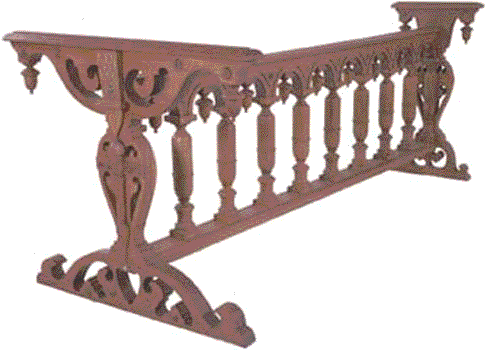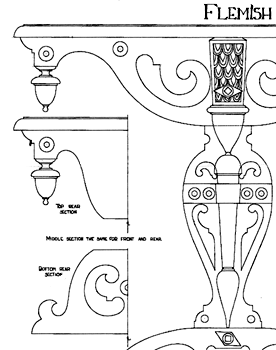D R A W I N G S
made by Grant O'Brien
Flemish double-manual harpsichord stand


The 'classic' Flemish harpsichord stand, this drawing is a compilation of the features, measurements and designs from a number of different stands under Ruckers harpsichords and virginals. For the most part, the basis of the drawing is the stand under the 1618 Andreas Ruckers double-manual harpsichord in the Musikinstrumenten Museum, Berlin. Unfortunately the original of this stand has been painted in oil paint over the original fumed oak decorations.
The stand should be made of fumed and rushed European oak. Before the oak is stained it should be 'rushed' (this was originally done with the business end of a bundle of rushes whose ends were aligned or cut to form a flat surface which was rubbed over the oak to raise and exaggerate the grain of the wood). The rushes were harder than the soft summer-growth wood of the stand and 'rubbed' it away. It's easiest today to do this with a steel wire brush. Brush the wood in the direction of the grain to remove the softer wood and leave the hard grain of the wood standing proud. How much you do this depends on how strong you want the 'rushed' effect to be. You should then stain the stand with a strong solution of chemical liquid ammonia (do it outside as its a bit toxic!). This is called 'fuming' the oak as it can be done by putting the oak and ammonia in an air-tight container and just letting the ammonia fumes do their work on the oak without 'painting' it onto the wood. (You could of course use ammonia made from urine instead of buying chemical ammonia. I have seen a seventeenth-century English recipe for making the stain for fumed oak that begins: "Use of horse piss 10 gallons - - -"!). Ammonia has the unusual effect as a stain of actually darkening the hard dark grain more than the soft wood - the opposite way around to normal solvent stains. After you have left the stained wood to dry neutralise the ammonia with a weak solution of vinegar and then wash it all off with water. Let it dry yet again. Then you should paint the stand in a weak solution of boiled linseed oil which 'dries' much more quickly than normal linseed oil. Leave the oiled wood for a month until the linseed oil is dry (an amazing chemical transformation occurs in the linseed oil after precisely 28 days, after which time it becomes almost insoluble), wax it with beeswax and polish it up with a soft cloth.
Return to the main catalogue of drawings
